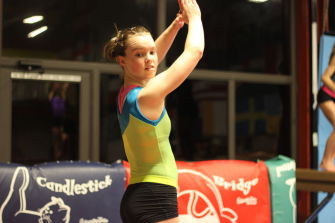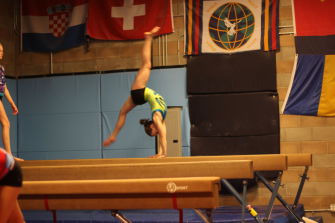Balancing Act: Students split time between gym and school
by Macrae Sharp
“On the beam, all you’re thinking about is making it back onto those four inches of wood. Everything has a mental aspect,” said freshman Lauren Smart.
Smart began practicing gymnastics when she was six years old, but only started competing four years ago after being inspired by the 2012 Summer Olympics.
Although gymnasts normally favor one event, according to Smart, they compete in all four: uneven bars, beam, floor, and vault.

“I do all four events, but I’d say floor [is my favorite] because it’s really upbeat. Your teammates can cheer you on during your routine,” Smart said.
However, Smart said that outside of competitions, her favorite event was the beam.
“But during meets, I got all sweaty and shaky, so that’s not as fun,” Smart said, in reference to the beam event.
According to Smart, she learns a new skill—or move—once every two weeks or so.
“Being around my teammates is really nice, and especially the satisfaction when you master a new skill,” Smart said. “Gymnastics lets me dance, on floor and on beam, and I love the balance aspect.”
Smart trains with her teammates at GymWorld in San Rafael four to five hours a day, five days a week.
She attended Redwood her first semester of freshman year, but this semester she transferred to Tamiscal because of her busy schedule.
Smart said that last semester, she went to the gym right after school, trained until 8:30 p.m., and arrived home by 9 p.m., so she didn’t start her homework at 9:30 p.m.
“I was really sleep deprived,” Smart said.
She hopes to switch gyms in order to train at Head Over Heels Athletic Arts in Emeryville, where she can further pursue her passion. Smart said that the program in the East Bay is more competitive than her current one, and she is excited to start training there with the goal of developing the skills to compete in college. Smart is currently on the gym’s waiting list.
However, her story is different from other girls, such as junior Ashlyn D’Orazio, who started gymnastics in kindergarten, but stopped after her sophomore year.
D’Orazio trained at Mega Gymnastics in San Rafael, but switched to practice at The Cave in Corte Madera because she was looking for a less competitive environment.
Unlike Smart, who plans to compete for years to come, D’Orazio said she did not enjoy competing.
“I hated actually competing because it’s stressful, and if you mess up then it’s over. If you fall off beam, you lose half-a-point—a big deduction—and it’s like, ‘Wow I’ve done that skill a thousand times perfectly in practice,’ and then you fall off,” D’Orazio said.
D’Orazio said being part of a gymnastics team introduces you to a great community of peers. She stayed close with her friends from middle school because they were all at the gym together for four hours a day.
However, D’Orazio highlighted that gymnastics is not a traditional team sport.
“You’re competitive with each other. It’s definitely not a team sport; it’s very individual. If you get a skill, your teammates will be happy for you because they’ve been through your struggle getting there, but it’s competing, and it’s individual,” D’Orazio said.
D’Orazio’s favorite apparatus to work on was the beam.
“It’s a large mental challenge because the skills that you do on beam you can already do on floor. You practice on a line, but then getting up on beam, it’s different,” D’Orazio said.
Although balancing and doing skills on a four-inch-wide wooden beam is intimidating, it’s also really fun, according to D’Orazio.
“Some of the skills are scary. I like that aspect of it. It’s very physically demanding but also mentally demanding too,” D’Orazio said.
However, last year D’Orazio quit competing due to the rigorous schedule and the large time commitment it required. She now coaches a few hours a week at The Cave, working with 6-12 year-old kids.
“Gymnastics has definitely changed me. Coaching is a different take on the sport, it’s a different way of looking at it,” D’Orazio said.
According to senior Nina Segedin, gymnastics is also a sport that requires a specific body type and size.
Segedin competed from the age of five until she was fourteen years old. However, during her sophomore year, she switched from gymnastics to rowing.
“I was getting too tall, and I had too many injuries,” Segedin said. “When you’re a gymnast, if you want to be successful you need a very specific body type, and normally that’s very short and pretty small so you can flip around easily.”
Segedin also said that the cause of her transition from gymnastics to rowing was her strong upper body, which she had developed through conditioning in the gym.

“I was physically ready, and since I was getting taller, that was good for rowing,” Segedin said.
Junior McKenna Bonkowski also switched from gymnastics to rowing when she was 13 years old because of her height.
“You have to be really strong to do the [events] in gymnastics, so that really helped with [switching] to rowing,” Bonkowski said.
Bonkowski began gymnastics at the age of three when her mother introduced her to the sport, and she competed throughout her childhood. She competed in all four events, but said she favored the vault and the uneven bars.
“I feel like not many people actually like beam. It’s four inches wide and four feet high and then you have to do a backflip. Bars were really fun because you’re swinging around,” Bonkowski said.
Segedin also competed in all four events, but she favored the uneven bars and the beam, especially due to her large amount of injuries.
“I was a little better at the beam and bars because that was less high-intensity stuff and less impact. It was more about lines and fluidity and gracefulness, which was better for me, instead of the tumbling,” Segedin said.
Segedin said that she loved gymnastics because of the personal gratification it gave her.
“It’s fun to do things that amaze other people, and it’s very satisfying,” Segedin said. “It’s satisfying to learn new things and it’s satisfying to put routines together and to improve.”






